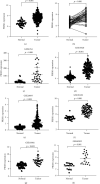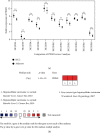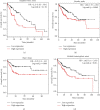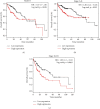DNA Primase Subunit 1 Expression in Hepatocellular Carcinoma and Its Clinical Implication
- PMID: 32908930
- PMCID: PMC7463366
- DOI: 10.1155/2020/9689312
DNA Primase Subunit 1 Expression in Hepatocellular Carcinoma and Its Clinical Implication
Abstract
DNA Primase Subunit 1 (PRIM1) is crucial for cancer development and progression. However, there remains a lack of comprehension concerning the clinical implication of PRIM1 in HCC. Here, aberrant expression of PRIM1 was identified in HCC according to available databases. The prognostic value of PRIM1 in patients presenting with HCC was further assessed based on TCGA data. Gene set enrichment analysis (GSEA) was subsequently conducted to investigate the potential function of PRIM1. Additionally, the correlations between tumor-infiltrating immune cells (TIICs) and PRIM1 expression were evaluated. The data from TCGA, GEO, ONCOMINE, and HCCDB databases illustrated that PRIM1 was overexpressed in HCC tissues, compared to normal liver tissues (all p < 0.05). Kaplan-Meier analysis revealed that high PRIM1 expression in HCC was closely correlated with worse overall survival (p < 0.05). The univariate and multivariate analyses illustrated that PRIM1 expression was an independent novel prognostic indicator in HCC. Additionally, the area under the receiver operating characteristic (AUROC) curve for PRIM1 reached 0.8651, indicating the diagnostic significance of PRIM1 in patients with HCC. GSEA showed that PRIM1 overexpression was significantly enriched in several tumor-related signaling pathways. Besides, TIIC analysis clarified the association between PRIM1 expression and TIICs in HCC. The findings disclose that PRIM1 profoundly implicated in promoting tumorigenesis might work as a desirable biomarker for HCC.
Copyright © 2020 Yipeng Zhang et al.
Conflict of interest statement
The authors declare that there are no conflicts of interest regarding the publication of this article.
Figures








Similar articles
-
Transcriptional analysis of the expression, prognostic value and immune infiltration activities of the COMMD protein family in hepatocellular carcinoma.BMC Cancer. 2021 Sep 7;21(1):1001. doi: 10.1186/s12885-021-08699-3. BMC Cancer. 2021. PMID: 34493238 Free PMC article.
-
Overexpression of PARPBP Correlates with Tumor Progression and Poor Prognosis in Hepatocellular Carcinoma.Dig Dis Sci. 2019 Oct;64(10):2878-2892. doi: 10.1007/s10620-019-05608-4. Epub 2019 Apr 4. Dig Dis Sci. 2019. PMID: 30949905
-
DNA primase subunit 1 deteriorated progression of hepatocellular carcinoma by activating AKT/mTOR signaling and UBE2C-mediated P53 ubiquitination.Cell Biosci. 2021 Feb 23;11(1):42. doi: 10.1186/s13578-021-00555-y. Cell Biosci. 2021. PMID: 33622397 Free PMC article.
-
Systematic summarization of the expression profiles and prognostic roles of the dishevelled gene family in hepatocellular carcinoma.Mol Genet Genomic Med. 2020 Sep;8(9):e1384. doi: 10.1002/mgg3.1384. Epub 2020 Jun 26. Mol Genet Genomic Med. 2020. PMID: 32588988 Free PMC article.
-
Loss of alanine-glyoxylate and serine-pyruvate aminotransferase expression accelerated the progression of hepatocellular carcinoma and predicted poor prognosis.J Transl Med. 2019 Nov 26;17(1):390. doi: 10.1186/s12967-019-02138-5. J Transl Med. 2019. PMID: 31771612 Free PMC article.
References
MeSH terms
Substances
LinkOut - more resources
Full Text Sources
Medical
Molecular Biology Databases

